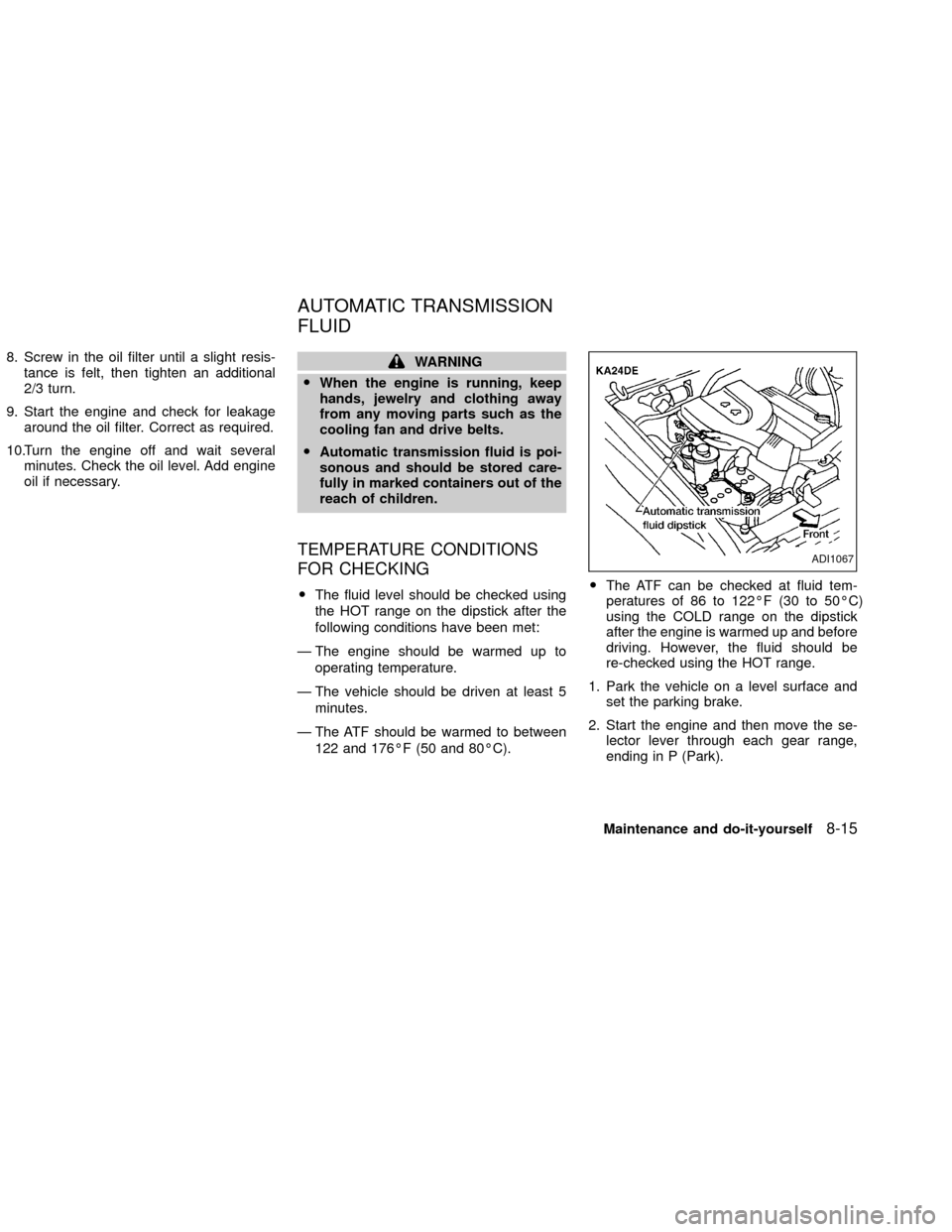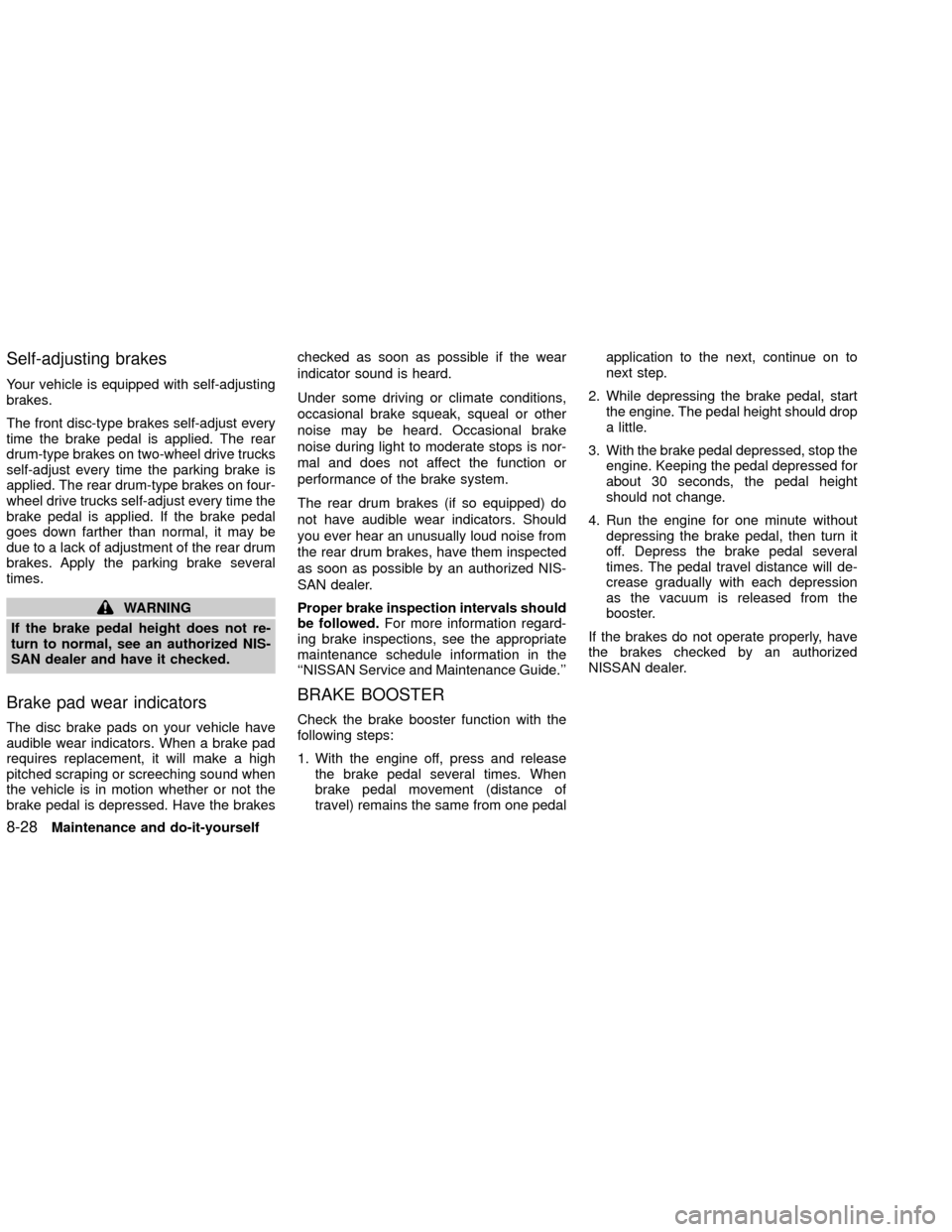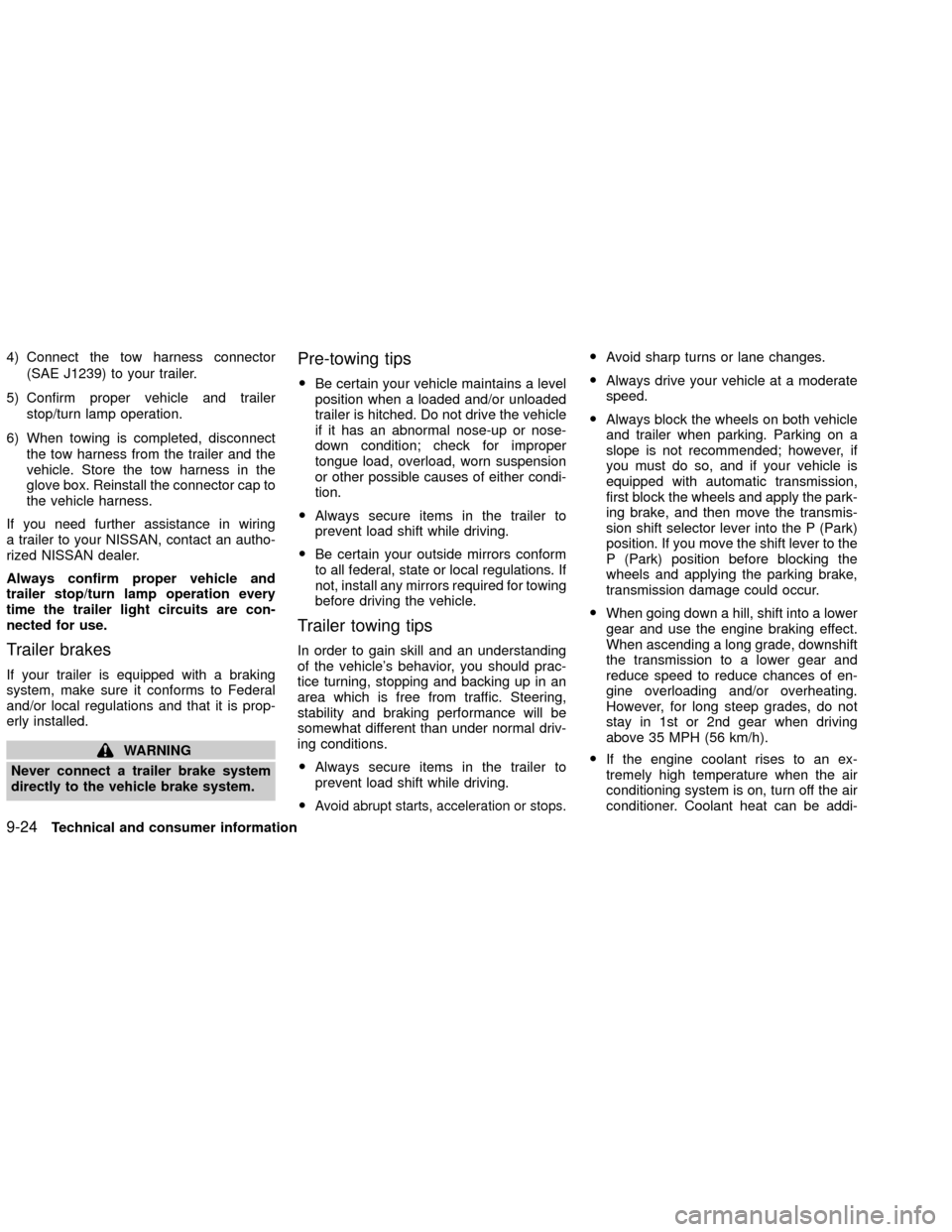check engine light NISSAN XTERRA 2002 WD22 / 1.G User Guide
[x] Cancel search | Manufacturer: NISSAN, Model Year: 2002, Model line: XTERRA, Model: NISSAN XTERRA 2002 WD22 / 1.GPages: 263, PDF Size: 2.22 MB
Page 187 of 263

Additional information on the following
items with an ``*'' is found later in this
section.
Warning lights and chimesMake sure all
warning lights and chimes are operating
properly.
Windshield wiper and washer*Check that
the wipers and washer operate properly and
that the wipers do not streak.
Windshield defrosterCheck that the air
comes out of the defroster outlets properly
and in sufficient quantity when operating the
heater or air conditioner.
Steering wheelCheck for changes in the
steering conditions, such as excessive free-
play, hard steering or strange noises.
SeatsCheck seat position controls such as
seat adjusters, seatback recliner, etc. to
ensure they operate smoothly and all
latches lock securely in every position.
Check that the head restraints move up and
down smoothly and the locks (if so
equipped) hold securely in all latched posi-
tions.
Seat beltsCheck that all parts of the seat
belt system (e.g., buckles, anchors, adjust-ers and retractors) operate properly and
smoothly, and are installed securely. Check
the belt webbing for cuts, fraying, wear or
damage.
Accelerator pedalCheck the pedal for
smooth operation and make sure the pedal
does not catch or require uneven effort.
Keep the floor mat away from the pedal.
Clutch pedal*Make sure the pedal oper-
ates smoothly and check that it has the
proper free travel.
BrakesCheck that the brakes do not pull
the vehicle to one side when applied.
Brake pedal and booster*Check the pedal
for smooth operation and make sure it has
the proper distance under it when de-
pressed fully. Check the brake booster func-
tion. Be certain to keep the floor mat away
from the pedal.
Parking brake*Check that the lever has
the proper travel and confirm that your
vehicle is held securely on a fairly steep hill
with only the parking brake applied.
Automatic transmission P (Park) posi-
tion mechanismCheck that the lock re-
lease button on the selector lever operatesproperly and smoothly. On a fairly steep hill
check that your vehicle is held securely with
the selector lever in the P position without
applying any brakes.
Under the hood and vehicle
The maintenance items listed here should
be checked periodically (e.g., each time you
check the engine oil or refuel).
Additional information on the following
items with an ``*'' is found later in this
section.
Windshield washer fluid*Check that there
is adequate fluid in the reservoir.
Engine oil level*Check the level after
parking the vehicle on a level surface with
the engine off. Wait a few minutes for the oil
to drain back into the oil pan.
Brake and clutch fluid levels*Make sure
that the brake and clutch fluid level is be-
tween the MIN and MAX lines on the reser-
voir.
Power steering fluid level* and lines
Check the level when the fluid is cold, with
the engine off. Check the lines for proper
attachment, leaks, cracks, etc.
8-4Maintenance and do-it-yourself
ZX
Page 198 of 263

8. Screw in the oil filter until a slight resis-
tance is felt, then tighten an additional
2/3 turn.
9. Start the engine and check for leakage
around the oil filter. Correct as required.
10.Turn the engine off and wait several
minutes. Check the oil level. Add engine
oil if necessary.WARNING
OWhen the engine is running, keep
hands, jewelry and clothing away
from any moving parts such as the
cooling fan and drive belts.
OAutomatic transmission fluid is poi-
sonous and should be stored care-
fully in marked containers out of the
reach of children.
TEMPERATURE CONDITIONS
FOR CHECKING
OThe fluid level should be checked using
the HOT range on the dipstick after the
following conditions have been met:
Ð The engine should be warmed up to
operating temperature.
Ð The vehicle should be driven at least 5
minutes.
Ð The ATF should be warmed to between
122 and 176ÉF (50 and 80ÉC).OThe ATF can be checked at fluid tem-
peratures of 86 to 122ÉF (30 to 50ÉC)
using the COLD range on the dipstick
after the engine is warmed up and before
driving. However, the fluid should be
re-checked using the HOT range.
1. Park the vehicle on a level surface and
set the parking brake.
2. Start the engine and then move the se-
lector lever through each gear range,
ending in P (Park).
ADI1067
AUTOMATIC TRANSMISSION
FLUID
Maintenance and do-it-yourself8-15
ZX
Page 201 of 263

CAUTION
Do not spill the fluid on any painted
surfaces. This will damage the paint. If
fluid is spilled, immediately wash the
surface with water.
WINDOW WASHER FLUID
RESERVOIR
CAUTION
ODo not substitute engine anti-freeze
coolant for windshield washer solu-
tion. This may result in damage to
the paint.
ODo not fill the window washer reser-
voir tank with washer fluid concen-
trates at full strength. Some methyl
alcohol based washer fluid concen-
trates may permanently stain thegrille if spilled while filling the win-
dow washer reservoir tank.
OPre-mix washer fluid concentrates
with water to the manufacturer's rec-
ommended levels before pouring the
fluid into the window washer reser-
voir tank. Do not use the window
washer reservoir tank to mix the
washer fluid concentrate and water.
For US
Check the window washer fluid level in the
reservoir tank and add fluid if necessary.
Add a washer solvent to the water for better
cleaning. In the winter season, add a wind-
shield washer anti-freeze. Follow the manu-
facturer's instructions for the mixture ratio.
For Canada
Add fluid when the low washer fluid warning
light comes on. Add windshield washer sol-
vent to the water for better cleaning. In the
winter season, add windshield washer anti-
freeze.
LDI0070
WINDOW WASHER FLUID
8-18Maintenance and do-it-yourself
ZX
Page 211 of 263

Self-adjusting brakes
Your vehicle is equipped with self-adjusting
brakes.
The front disc-type brakes self-adjust every
time the brake pedal is applied. The rear
drum-type brakes on two-wheel drive trucks
self-adjust every time the parking brake is
applied. The rear drum-type brakes on four-
wheel drive trucks self-adjust every time the
brake pedal is applied. If the brake pedal
goes down farther than normal, it may be
due to a lack of adjustment of the rear drum
brakes. Apply the parking brake several
times.
WARNING
If the brake pedal height does not re-
turn to normal, see an authorized NIS-
SAN dealer and have it checked.
Brake pad wear indicators
The disc brake pads on your vehicle have
audible wear indicators. When a brake pad
requires replacement, it will make a high
pitched scraping or screeching sound when
the vehicle is in motion whether or not the
brake pedal is depressed. Have the brakeschecked as soon as possible if the wear
indicator sound is heard.
Under some driving or climate conditions,
occasional brake squeak, squeal or other
noise may be heard. Occasional brake
noise during light to moderate stops is nor-
mal and does not affect the function or
performance of the brake system.
The rear drum brakes (if so equipped) do
not have audible wear indicators. Should
you ever hear an unusually loud noise from
the rear drum brakes, have them inspected
as soon as possible by an authorized NIS-
SAN dealer.
Proper brake inspection intervals should
be followed.For more information regard-
ing brake inspections, see the appropriate
maintenance schedule information in the
``NISSAN Service and Maintenance Guide.''
BRAKE BOOSTER
Check the brake booster function with the
following steps:
1. With the engine off, press and release
the brake pedal several times. When
brake pedal movement (distance of
travel) remains the same from one pedalapplication to the next, continue on to
next step.
2. While depressing the brake pedal, start
the engine. The pedal height should drop
a little.
3. With the brake pedal depressed, stop the
engine. Keeping the pedal depressed for
about 30 seconds, the pedal height
should not change.
4. Run the engine for one minute without
depressing the brake pedal, then turn it
off. Depress the brake pedal several
times. The pedal travel distance will de-
crease gradually with each depression
as the vacuum is released from the
booster.
If the brakes do not operate properly, have
the brakes checked by an authorized
NISSAN dealer.
8-28Maintenance and do-it-yourself
ZX
Page 230 of 263

If any driveability problems such as engine
stalling and hard hot starting are experi-
enced after using oxygenate-blend fuels,
immediately change to a non-oxygenate
fuel or a fuel with a low blend of MTBE.
Take care not to spill gasoline during
refueling. Gasoline containing oxygen-
ates can cause paint damage.
After Market Fuel Additives
NISSAN does not recommend the use of
any fuel additives (i.e., fuel injector cleaner,
octane booster, intake valve deposit remov-
ers, etc.) which are sold commercially. Many
of these additives intended for gum, varnish
or deposit removal may contain active sol-
vents or similar ingredients that can be
harmful to the fuel system and engine.
Octane rating tips
In most parts of North America, you should
use unleaded gasoline with an octane rating
of at least 87 (except supercharger) or 91
(supercharger) AKI (Anti-Knock Index).
However, you may use unleaded gasoline
with an octane rating as low as 85 AKI in
high altitude areas (over 4,000 ft [1,219 m])
such as: Colorado, Montana, New Mexico,
Utah, Wyoming, northeastern Nevada,southern Idaho, western South Dakota,
western Nebraska, and the part of Texas
which is directly south of New Mexico.
Using unleaded gasoline with an octane
rating lower than stated above can cause
persistent, heavy ``spark knock.'' (``Spark
knock'' is a metallic rapping noise.) If
severe, this can lead to engine damage. If
you detect a persistent heavy spark
knock even when using gasoline of the
stated octane rating, or if you hear steady
spark knock while holding a steady speed
on level roads, have an authorized NIS-
SAN dealer correct the condition. Failure
to correct the condition is misuse of the
vehicle, for which NISSAN is not respon-
sible.
Incorrect ignition timing may result in spark
knock, after-run and/or overheating, which
may cause excessive fuel consumption or
engine damage. If any of the above symp-
toms are encountered, have your vehicle
checked at an authorized NISSAN dealer.
However, now and then you may notice
light spark knock for a short time while
accelerating or driving up hills. This is
no cause for concern, because you get
the greatest fuel benefit when there islight spark knock for a short time under
heavy engine load.
Technical and consumer information
9-5
ZX
Page 249 of 263

4) Connect the tow harness connector
(SAE J1239) to your trailer.
5) Confirm proper vehicle and trailer
stop/turn lamp operation.
6) When towing is completed, disconnect
the tow harness from the trailer and the
vehicle. Store the tow harness in the
glove box. Reinstall the connector cap to
the vehicle harness.
If you need further assistance in wiring
a trailer to your NISSAN, contact an autho-
rized NISSAN dealer.
Always confirm proper vehicle and
trailer stop/turn lamp operation every
time the trailer light circuits are con-
nected for use.
Trailer brakes
If your trailer is equipped with a braking
system, make sure it conforms to Federal
and/or local regulations and that it is prop-
erly installed.
WARNING
Never connect a trailer brake system
directly to the vehicle brake system.
Pre-towing tips
OBe certain your vehicle maintains a level
position when a loaded and/or unloaded
trailer is hitched. Do not drive the vehicle
if it has an abnormal nose-up or nose-
down condition; check for improper
tongue load, overload, worn suspension
or other possible causes of either condi-
tion.
OAlways secure items in the trailer to
prevent load shift while driving.
OBe certain your outside mirrors conform
to all federal, state or local regulations. If
not, install any mirrors required for towing
before driving the vehicle.
Trailer towing tips
In order to gain skill and an understanding
of the vehicle's behavior, you should prac-
tice turning, stopping and backing up in an
area which is free from traffic. Steering,
stability and braking performance will be
somewhat different than under normal driv-
ing conditions.
OAlways secure items in the trailer to
prevent load shift while driving.
O
Avoid abrupt starts, acceleration or stops.
OAvoid sharp turns or lane changes.
OAlways drive your vehicle at a moderate
speed.
OAlways block the wheels on both vehicle
and trailer when parking. Parking on a
slope is not recommended; however, if
you must do so, and if your vehicle is
equipped with automatic transmission,
first block the wheels and apply the park-
ing brake, and then move the transmis-
sion shift selector lever into the P (Park)
position. If you move the shift lever to the
P (Park) position before blocking the
wheels and applying the parking brake,
transmission damage could occur.
OWhen going down a hill, shift into a lower
gear and use the engine braking effect.
When ascending a long grade, downshift
the transmission to a lower gear and
reduce speed to reduce chances of en-
gine overloading and/or overheating.
However, for long steep grades, do not
stay in 1st or 2nd gear when driving
above 35 MPH (56 km/h).
OIf the engine coolant rises to an ex-
tremely high temperature when the air
conditioning system is on, turn off the air
conditioner. Coolant heat can be addi-
9-24Technical and consumer information
ZX
Page 256 of 263

10 Index
A
Air bag (See supplemental restraint
system)....................................................... 1-11
Air bag warning light .................................. 1-14
Air cleaner housing filter ............................ 8-23
Air conditioner
Air conditioner operation ........................ 4-5
Air conditioner service ............................ 4-9
Air conditioner specification label ......... 9-14
Air conditioner system refrigerant and
lubrication recommendations.................. 9-8
Heater and air conditioner controls ........ 4-3
Air flow charts .............................................. 4-6
Alarm system (See theft warning) ............. 2-15
Anchor point locations ............................... 1-36
Antenna...................................................... 4-31
Anti-lock brake system (ABS).................... 5-26
Anti-lock brake warning light...................... 2-11
Ashtray (See cigarette lighter and
ashtray) ...................................................... 2-23
Audio system
FM-AM radio with cassette player and
compact disc (CD) player ..................... 4-13
FM-AM radio with compact disc (CD)
changer ................................................. 4-18
Steering wheel audio control switch ..... 4-30
Auto-lock free-running hubs ...................... 5-19Automatic
Automatic power window switch .......... 2-31
Automatic transmission fluid (ATF)....... 8-15
Driving with automatic transmission ....... 5-9
Transmission selector lever lock
release .................................................. 5-12
B
Battery........................................................ 8-19
Battery replacement (See remote keyless
entry system) ............................................... 3-7
Before starting the engine ........................... 5-8
Belts (See drive belts) ............................... 8-20
Brake
Anti-lock brake system (ABS) .............. 5-26
Brake booster ....................................... 8-28
Brake fluid ..................................... 8-17, 9-3
Brake pedal .......................................... 8-27
Brake system ........................................ 5-25
Brake warning light ............................... 2-11
Brake wear indicators ................. 2-14, 8-28
Parking brake check ............................. 8-27
Parking brake operation ....................... 5-14
Break-in schedule ...................................... 5-17
Bulb check/instrument panel ..................... 2-10C
Capacities and recommended fuel/
lubricants...................................................... 9-2
Car phone or CB radio .............................. 4-31
Cargo (See vehicle loading information) ... 9-15
Check engine indicator light
(See malfunction indicator light) ................ 2-14
Child restraint with top tether strap ........... 1-35
Child restraints ........................................... 1-24
Child safety rear door lock .......................... 3-4
Cigarette lighter (accessory) and
ashtray ....................................................... 2-23
Cleaning exterior and interior ...................... 7-2
Clutch
Clutch fluid ............................................ 8-17
Clutch pedal.......................................... 8-29
Cold weather driving .................................. 5-27
Controls
Audio controls (steering wheel) ............ 4-30
Heater and air conditioner controls ........ 4-3
Coolant
Capacities and recommended fuel/
lubricants ................................................ 9-2
Changing engine coolant ...................... 8-11
Checking engine coolant level ............. 8-10
Engine coolant temperature gauge ........ 2-5
Corrosion protection .................................... 7-5
ZX
Page 257 of 263

Cover
Tonneau cover ...................................... 2-29
Cruise control............................................. 5-15
Cup holders ............................................... 2-26
D
Daytime running light system
(Canada only) ............................................ 2-21
Defogger switch
Rear window defogger switch .............. 2-20
Dimensions and weights ............................ 9-11
Door locks .................................................... 3-2
Drive belts .................................................. 8-20
Driving
Auto-lock free-running hubs ................. 5-19
Cold weather driving............................. 5-27
Driving with automatic transmission ....... 5-9
Driving with manual transmission ......... 5-13
Precautions when starting and driving ... 5-2
E
Economy - fuel........................................... 5-17
Emission control information label............. 9-14
Emission control system warranty ............. 9-26
Engine
Before starting the engine ...................... 5-8
Capacities and recommended fuel/
lubricants ................................................ 9-2
Changing engine coolant ...................... 8-11Changing engine oil.............................. 8-13
Changing engine oil filter...................... 8-14
Checking engine coolant level ............. 8-10
Checking engine oil level ...................... 8-11
Engine compartment check locations .... 8-7
Engine coolant temperature gauge ........ 2-5
Engine cooling system ......................... 8-10
Engine oil .............................................. 8-11
Engine oil and oil filter
recommendation ..................................... 9-6
Engine oil pressure warning light ......... 2-12
Engine oil viscosity ................................. 9-7
Engine serial number ........................... 9-13
Engine specifications .............................. 9-9
Starting the engine ................................. 5-8
Exhaust gas (Carbon monoxide) ................. 5-2
F
First aid kit ................................................... 6-2
Flashers (See hazard warning flasher
switch) ........................................................ 2-22
Floor mat positioning aid ............................. 7-4
Fluid
Automatic transmission fluid (ATF)....... 8-15
Brake fluid ..................................... 8-17, 9-3
Capacities and recommended fuel/
lubricants ................................................ 9-2
Clutch fluid ............................................ 8-17
Engine coolant ...................................... 8-10
Engine oil .............................................. 8-11
Power steering fluid .............................. 8-17Window washer fluid ............................ 8-18
F.M.V.S.S. certification label ...................... 9-13
Front seats
Separate ................................................. 1-2
Fuel
Capacities and recommended fuel/
lubricants ................................................ 9-2
Fuel economy ....................................... 5-17
Fuel filler cap ........................................ 3-13
Fuel gauge.............................................. 2-6
Fuel octane rating................................... 9-5
Fuel recommendation ............................. 9-4
Fuses ......................................................... 8-30
G
Gauge
Engine coolant temperature gauge ........ 2-5
Fuel gauge.............................................. 2-6
Odometer ................................................ 2-3
Speedometer .......................................... 2-3
Tachometer ............................................. 2-5
Gear Basket (see roof rack with gear
basket) ....................................................... 3-10
General maintenance .................................. 8-3
H
Hazard warning flasher switch .................. 2-22
Headlight and turn signal switch ............... 2-20
Headlights .................................................. 8-32
10-2
ZX
Page 258 of 263

Heater
Heater and air conditioner controls ........ 4-3
Heater operation ..................................... 4-4
Hood release ............................................... 3-8
Hubs
Auto-lock free-running hubs ................. 5-19
I
Ignition switch .............................................. 5-6
Indicator lights and audible reminders
(See warning/indicator lights and audible
reminders) .................................................. 2-10
Inside mirror ............................................... 3-15
Instrument brightness control .................... 2-21
Interior light and cargo light ....................... 2-33
J
Jump starting ............................................... 6-8
K
Key ............................................................... 3-2
Keyless entry system (See remote keyless
entry system) ............................................... 3-4L
Labels
Air conditioner specification label ......... 9-14
Emission control information label........ 9-14
Engine serial number ........................... 9-13
F.M.V.S.S. certification label ................. 9-13
Vehicle identification number (VIN)
plate ...................................................... 9-12
Warning labels (for SRS)...................... 1-14
Light
Air bag warning light............................. 1-14
Bulb check/instrument panel ................ 2-10
Headlight and turn signal switch .......... 2-20
Headlights ............................................. 8-32
Interior light and cargo light .................. 2-33
Light bulbs ............................................ 8-32
Spotlights (See map light) .................... 2-34
Warning/indicator lights and audible
reminders .............................................. 2-10
Lock
Child safety rear door lock ..................... 3-4
Door locks............................................... 3-2
Power door locks .................................... 3-3
Rear door lock ........................................ 3-9
Luggage rack ............................................. 3-10
Luggage rack (see roof rack) .................... 3-10
Luggage rack (see roof rack with gear
basket) ....................................................... 3-10
Luggage (See vehicle loading
information) ................................................ 9-15M
Maintenance
General maintenance ............................. 8-3
Inside the vehicle.................................... 8-3
Maintenance precautions ....................... 8-5
Outside the vehicle ................................. 8-3
Seat belt maintenance.......................... 1-24
Under the hood and vehicle ................... 8-4
Malfunction indicator lamp (MIL) ............... 2-14
Manual windows ........................................ 2-31
Map lights .................................................. 2-34
Meters and gauges .............................. 2-2, 2-3
Mirror
Inside mirror.......................................... 3-15
Outside mirror control ........................... 3-16
Multi-remote control system (See remote
keyless entry system) .................................. 3-4
O
Octane rating (See fuel octane rating) ........ 9-5
Odometer ..................................................... 2-3
Oil
Capacities and recommended fuel/
lubricants ................................................ 9-2
Changing engine oil.............................. 8-13
Changing engine oil filter...................... 8-14
Checking engine oil level ...................... 8-11
Engine oil .............................................. 8-11
10-3
ZX
Page 259 of 263

Engine oil and oil filter
recommendation ..................................... 9-6
Engine oil viscosity ................................. 9-7
Outside mirror control ................................ 3-16
Overheat
If your vehicle overheats ...................... 6-10
Owner's manual order form ....................... 9-29
P
Parking
Parking brake check ............................. 8-27
Parking brake operation ....................... 5-14
Parking/parking on hills ........................ 5-24
Power
Power door locks .................................... 3-3
Power steering fluid .............................. 8-17
Power steering system ......................... 5-25
Power windows..................................... 2-30
Precautions
Maintenance precautions ....................... 8-5
On-pavement and off-road driving
precautions ............................................. 5-3
Precautions on seat belt usage............ 1-16
Precautions when starting and driving ... 5-2
Push starting .............................................. 6-10R
Radio
Car phone or CB radio ......................... 4-31
FM-AM radio with cassette player and
compact disc (CD) player ..................... 4-13
FM-AM radio with compact disc (CD)
changer ................................................. 4-18
Steering wheel audio control switch ..... 4-30
Readiness for inspection maintenance
(I/M) test..................................................... 9-27
Rear anti-lock brake warning light ............. 2-11
Rear door lock ............................................. 3-9
Rear seat .............................................. 1-3, 1-5
Rear window defogger switch ................... 2-20
Rear window wiper and washer
switches ..................................................... 2-19
Registering your vehicle in another
country ....................................................... 9-12
Remote keyless entry system ..................... 3-4
Reporting safety defects (USA) ................. 9-27
Roof rack with gear basket........................ 3-10
S
Safety
Child safety rear door lock ..................... 3-4
Reporting safety defects (USA) ............ 9-27Seat belt
Precautions on seat belt usage............ 1-16
Seat belt extenders .............................. 1-23
Seat belt maintenance.......................... 1-24
Seat belts.............................................. 1-16
Three-point type with retractor ............. 1-19
Two-point type without retractor
(rear center lap belt) ............................. 1-21
Seat belt warning light ............................... 2-12
Seats
Adjustment .............................................. 1-2
Rear seat......................................... 1-3, 1-5
Separate seats ....................................... 1-2
Service manual order form ........................ 9-29
Shifting
Manual transmission............................. 5-13
Spark plug replacement............................. 8-21
Speedometer ............................................... 2-3
Spotlights (See map light) ......................... 2-34
SRS warning label ..................................... 1-14
Starting
Before starting the engine ...................... 5-8
Jump starting .......................................... 6-8
Precautions when starting and driving ... 5-2
Push starting......................................... 6-10
Starting the engine ................................. 5-8
Steering
Power steering fluid .............................. 8-17
Power steering system ......................... 5-25
Tilting steering wheel ............................ 3-14
10-4
ZX